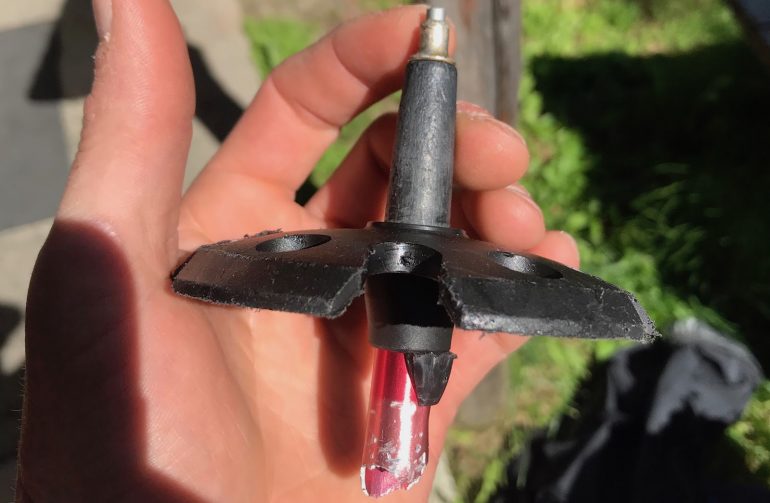Tech Tuesday is recurring segment sponsored by Dynafit to get you in the right touring gear and make sure you know how to use it.
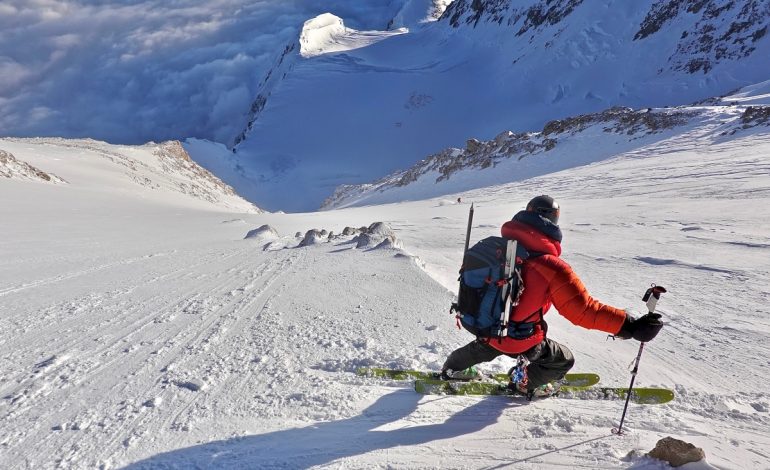
Drew watches Cal (far away center) ski the Messner Couloir in tricky conditions. His skis were some of the larger you would find on Denali and it paid off here. Photo @g.allen.smith
Denali expedition tips for skis, crampons, clothes and more
Part one of What Worked, What Didn’t covered climbing and camping gear used on our Denali ski trip. This was our longest and coldest winter camping mission to date. It went over well thanks largely to great advice from friends and the WildSnow archives. Our prior experience lies more on the skiing side of things, and ski we did on Denali with fantastic conditions for the high alpine. Below is my take on what worked and what didn’t once it was sending time.
Skis/Bindings/Skins
My go-to ski mountaineering setup is the Black Crows Navis Freebird in a 179cm length with a Dynafit SuperRadical binding. The Navis Free is the perfect shape and width for my preferences to encounter any type of snow. You could carry a much lighter ski (we saw several race or near race weight setups), but chances are you will ski both powder and ice on Denali and do so with a heavier than normal load. Cal took an even bigger 185cm Black Diamond Route 105 and skied the most confidently in the punchy wind-effect of the steep Messner Couloir.
And no, that Dynafit binding name is not a typo, just my name for a Superlite 2.0 heel piece with a Radical toe piece. The toe unit is the most important part of the tech binding, and the steel Radical toe is tried and true. A Superlite heel unit with the 12 spring is compact, simple, and punches way above its weight. This has been my go-to light but strong mountaineering binding for several years now and did well on Denali. Drew also used this combo on his 184 K2 Wayback 96. Always use a leash in distant or glaciated big mountain terrain.
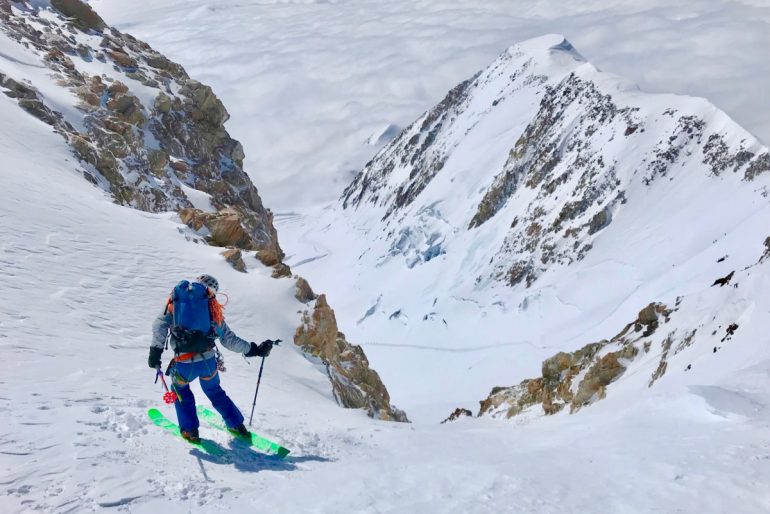
Dusting off the cobwebs on the first jump turn of the trip, trusty Navis below foot confidently clamped to Hoji Pro Tours with ‘SuperRadicals’. Photo @bigmountaincreative
My Pomoca Pro S Glide skins glided well on the long flat approach of the lower glacier and gripped well on the mixed conditions of the lower Headwall and lower Orient Express. We skinned every day that we skied, though it would be reasonable to start in crampons right from your tent. The day before our successful summit bid via the Orient, we put in a 2,400 vertical foot skin track just past the West Rib cutoff and skied a powder lap. The next morning we were able to fly right back to the top of the track in only an hour and a half, saving energy for the rest of the climb.
Ski Boots
A slightly modded Dynafit Hoji Pro Tour with a Maestrale RS Intuition liner was my non-camp slipper of choice. The range of motion in the Hoji Lock system is phenomenal given the stiff downhill performance. The toe box is vertically roomy which helped with warmth. I could not use my Forty Below overboots while in my skis due to the speed nose shape. Though I cut the overboots at home and successfully bench tested the fit, real world application in the Alaskan environs was near impossible. I skinned and skied without the overboots and wore them while cramponing on the high mountain.
All three of the team skied in our normal sized (read alpine style downsizing) ski boots. This was a significant departure from a lot of advice, but again, we are skiers first. Cal and Drew managed with the Forty Belows and quick transitions. I kept warm while skinning and skiing in snug shells thanks to Lenze 5.0 heated socks. The Lenze sock is in a class of its own and the larger 1800 battery was perfect for all day use in the cold. They fit great, are easy to use, and charge via USB which is required for the solar panel.
Technical gear
I used the steel Cassin Alpinist crampons with the semi automatic toe. They walk super smoothly and install easily with gloves on. The semi auto is necessitated by my ski boots but was quite solid and quick to install. All three of us wore the Black Diamond Couloir harness which is great for putting on (or removing for the emergency bathroom break) with skis or crampons on. We all brought two axes and carried both most days. I used a Petzl Sum’tec hammer and a Camp Corsa Nanotech adze. I brought along a cheap 3mm foam sleeping pad to cut up and tape around metal tools to insulate our hands from them. Use athletic tape, not cold-conducting duct tape.
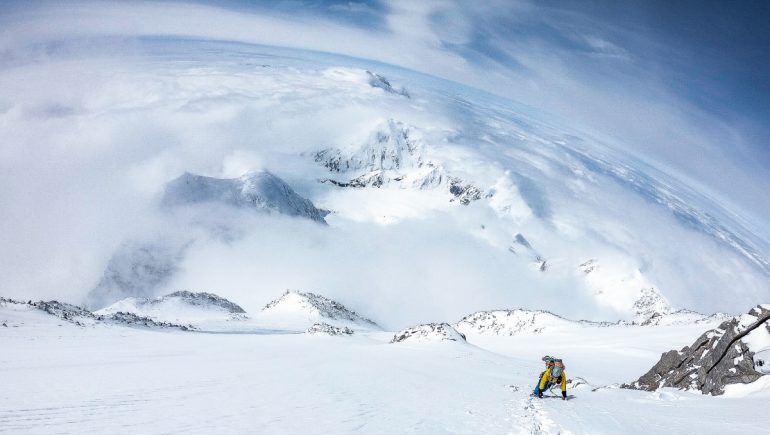
Two tool front pointing as the top of the Orient steepens. Two axes a must, especially if your team might deviate from the standard West Buttress Route. Photo @bigmountaincreative
With such unique soft conditions, I would have been completely comfortable in all lightweight (aluminum or mostly aluminum Nano-esque) gear — saving hundreds of precious grams. However those conditions are generally not the case. A safer minimal weight kit would be something like the Petzl Irvis Hybrid crampons and an axe setup similar to mine with one light but steel tool and one steel reinforced aluminum.
We used the Petzl RAD line for rope with their Micro Traction and Tibloc system for rescue. I opted to leave my ascender at the plane hanger last minute in favor of using the micro traction on the fixed line and for any self rescue. The little locking pulley worked great and was only a shade slower resetting at each fixed point. We brought only one picket for an emergency “leaver” anchor, opting to stay light and rely on deadmanning axes for crevasse rescue.
All of us brought whippet poles which are great for self arrest in the case of a partner crevasse fall while approaching in long flat glaciate terrain. I greatly prefer an axe when traveling in steeps, and make one readily available either via the quick-deploy piolet system of my Cirque pack or by tucking one in the shoulder strap. Furthermore, whippets are adjustable poles which I don’t care for due to fragility and my sometimes careless treatment of equipment.
Case in point, I lost the lowest section of my triple section carbon whippet while it was on my back somewhere between 14k and 17k Camp. While we waited for some weather to pass, I modified someone else’s lost pole with a basket from my repair kit. The basket only fit upside down; I had to break off most of the newly adopted pole, and then insert this into the remaining two sections of the whippet pole. I was left with a roughly 70 cm pole and upside down basket to climb to the summit ridge and ski the Messner Couloir. We did have a backup pole at camp which I would highly recommend.
Clothing Layers
I felt super dialed with clothing, and wouldn’t change a thing. For three days on the lower mountain (two up, one down) I wore thin synthetic bottom layers, and thin Smartwool sun hoody. On the upper mountain I lived in Smartwool boxer briefs, Helly Hansen Warm ¾ length long underwear, a LaBent wool T and The North Face power grid hoodie.
For mid layer insulation, I used Ventrix pieces from The North Face. Ventrix is a lightweight synthetic insulator that is wrapped in highly breathable perforated fabric that vents more when you are moving. I used the jacket some during the winter and got a pair of the new Ventrix knickers for Denali. The knickers were simply amazing and tied with the Lenze socks for the best piece of gear I brought up. In fact, I wore the Ventrix top and bottom for 11 days straight, including while sleeping. The knickers allowed me to summit and transition in the -20 to -30 degree temps without putting on my down pants, a pain in the butt with crampons. I carried a TNF Proprius hoodie, a similarly weighted insulator during missions which trades breathability for weather resistance.
Shell layers were a pre-production FutureLight Summit Series jacket from The North Face and Dynafit Radical GoreTex C-Knit pants. Both were excellent. Upper body mobility and breathability in The North Face’s new layering system was amazing despite not having a single vent. The Dynafit pants side vent lines up with the vent on the knickers to dump heat. The pants also have bomber reinforced cuffs and snow gaiters, which I thought were important for this trip.
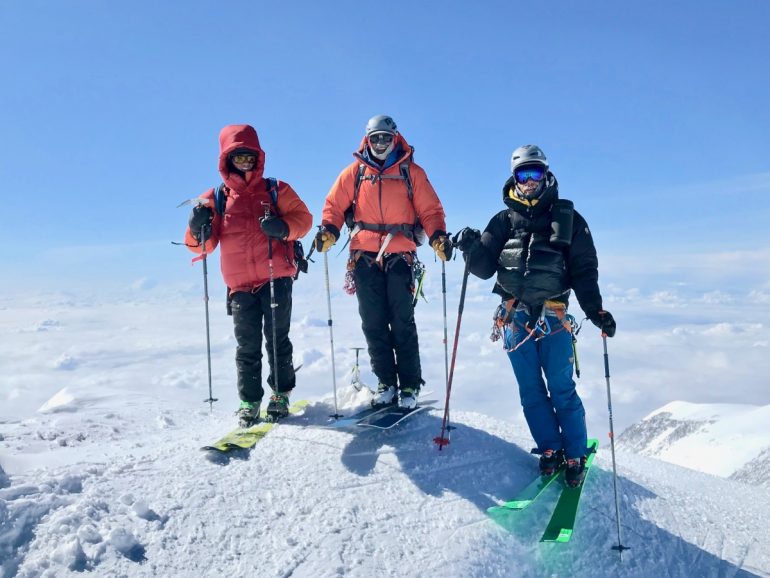
Incredible what modern clothing and a little sunshine can do. We were all fairly comfortable and enjoyed the solar gain on the top.
My North Face Summit L6 Down Belay Parka was the warmest parka of the team. Rab Photon insulated pants were good at camp and great insurance everytime we left camp. On our first successful summit bid we put on outer puffy layers too soon which slowed us down. The second summit bid I didn’t put on the pants at all and the jacket only on the summit ridge.
Summit/ski pack
Drew and I brought separate ski packs, but Cal removed the top lid from his Aether Pro and was happy with that. I was psyched to have my favorite ski pack– the Black Diamond Cirque 45. Forty-five liters was just enough for Denali day missions, and even a summit climb and ski from 14k Camp. I fastened an OR bottle jacket to the front of the shoulder strap, rando racing style, which proved handy and freed up vital space. Without the two ski packs in addition to the large packs, descending from 14k Camp without sleds would have required larger big packs.
Gloves
Three weight classes worked well for me. The North Face Gore Closefit Tricot glove was fantastic on the lower mountain and warmer times on the high mountain. It is a super unique three layer shell glove that is about as thin as a medium weight liner glove. I wore them as liners a few times as well. The Black Diamond Guide Finger filled the middleweight slot. The finger or lobster claw design is great for rope work and climbing transitions. They are quite warm; Cal even stayed in his through the summit transition. The North Face Nuptse Mitt was fantastic for slow times and the summit ridge, like a -40 bag for your hands.
Team
Choose a great squad that you know and trust, and suffer with them many times in advance. I have been ski mountaineering with these guys for four years now and not only trust them with my life, but trust them to get the goods and do so lightheartedly. The team is the most important part of the “kit”, and the only thing you can’t borrow or buy!
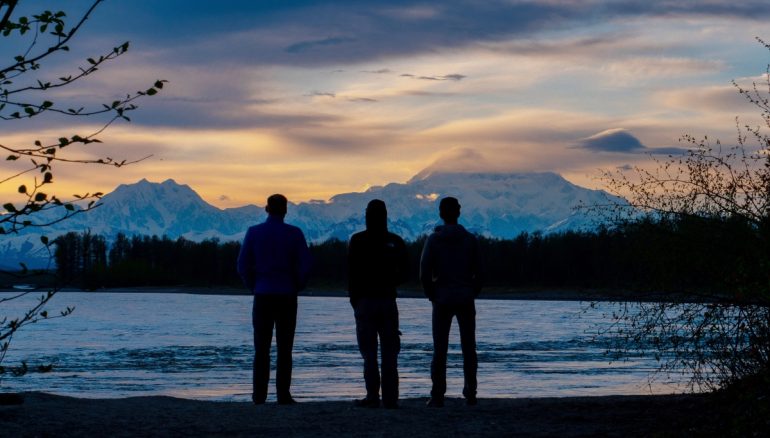
Eyeing up the objective. Cal, Gary, and Drew at the confluence of the Talkeetna and Susitna rivers the evening prior to departure. Photo @bigmountaincreative
WildSnow guest blogger Gary Smith is an avid backcountry skier and ski mountaineer residing in Eagle County, Colorado.
On March 22nd 2021, Gary Smith tragically died in an avalanche outside of Beaver Creek Resort in Colorado. Since 2018, Gary has been a frequent and insightful contributor to WildSnow. From Christmas Eve spent at the Wildsnow Field HQ cabin, to testing gear and sharing his love for steep skiing around the world, he was a pillar of the ski touring community and will be greatly missed.

